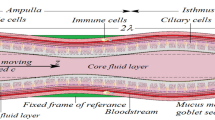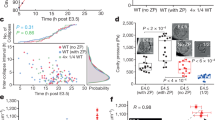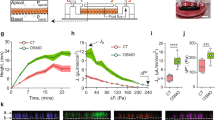Abstract
FLUID and solutes accumulate in the blastocyst just before implantation by transport mechanisms associated with the trophectoderm1–3. This structure is a simple squamous epithelium that surrounds the embryo, and it is the first tissue to develop in the mammalian embryo4. We describe here electrophysiological experiments which demonstrate changes in transport functions of this epithelium in the rabbit a few hours before, the expected time of implantation. At this time fluid is accumulating rapidly in the blastocoele5. The following results show that between 6 and 7-d post-coitum (p.c.) a transtrophectodermal, rheogenic, amiloride-sensitive Na+ transport system develops. The term ‘rheogenic’ characterises non-neutral or current-generating transport process, as opposed to the term ‘electrogenic’ which is more general and characterises any process (diffusion potentials, electrokinetic phenomena, and/or rheogenic transport) which results in a change in potential across an epithelium6.
This is a preview of subscription content, access via your institution
Access options
Subscribe to this journal
Receive 51 print issues and online access
$199.00 per year
only $3.90 per issue
Buy this article
- Purchase on Springer Link
- Instant access to full article PDF
Prices may be subject to local taxes which are calculated during checkout
Similar content being viewed by others
References
Biggers, J. D. & Borland, R. M. A. Rev. Physiol. 381, 95–119 (1976).
Borland, R. M. in Development in Mammals 1 (ed. Johnson, M. H.) (Elsevier-North Holland, Amsterdam. 1977).
Biggers, J. D., Borland, R. M. & Powers, R. D. Ciba Fdn Symp. 52, 129–153 (1977).
Gardner, R. L. & Papaiàannou, V. E. in The Early Development of Mammals (eds Balls, M. & Wild, A. E.) Cambridge (1975).
Daniel, J. C. Am. Nat. 98, 85–98 (1964).
Schultz, S. G., Frizzel, R. A. & Nellans, H. N. A. Rev. Physiol. 36, 51–91 (1974).
Powers, R. D. & Tupper, J. T. Devl Biol. 38, 320–331 (1974).
Borland, R. M., Biggers, J. D. & Lechene, C. P. Devl Biol. 50, 201–211 (1975).
Van Blerkom, J. & Manes, C. Devl Biol. 40, 40–51 (1974).
Van Blerkom, J., Manes, C. & Daniel, J. C. Devl Biol. 35, 262–282 (1973).
Cross, M. H. & Brinster, R. L. Expl Cell Res. 58, 125–127 (1969); 62, 303–309 (1970).
Dörge, A. & Nagel, W. Pflügers Arch. ges. Physiol. 321, 91–101 (1970).
Salako, L. A. & Smith, A. J. Br. J. Pharmac. 38, 702–718 (1970).
Ussing, H. H., Erlij, D. & Lassen, U. A. Rev. Physiol. 36, 17–49 (1974).
Cross, M. H. Biol. Reprod. 8, 566–575 (1973).
Ducibella, T., Albertini, D. F., Anderson, E. & Biggers, J. D. Devl Biol. 45, 231–250 (1975).
Hastings, R. A. & Enders, A. C. Anat. Rec. 181, 17–34 (1975).
Author information
Authors and Affiliations
Rights and permissions
About this article
Cite this article
POWERS, R., BORLAND, R. & BIGGERS, J. Amiloride-sensitive rheogenic Na+ transport in rabbit blastocyst. Nature 270, 603–604 (1977). https://doi.org/10.1038/270603a0
Received:
Accepted:
Issue Date:
DOI: https://doi.org/10.1038/270603a0
This article is cited by
-
Ion transport across the early chick embryo: I. Electrical measurements, ionic fluxes and regional heterogeneity
The Journal of Membrane Biology (1994)
-
Ion transport across the early chick embryo: II. Characterization and pH sensitivity of the transembryonic short-circuit current
The Journal of Membrane Biology (1994)
Comments
By submitting a comment you agree to abide by our Terms and Community Guidelines. If you find something abusive or that does not comply with our terms or guidelines please flag it as inappropriate.



